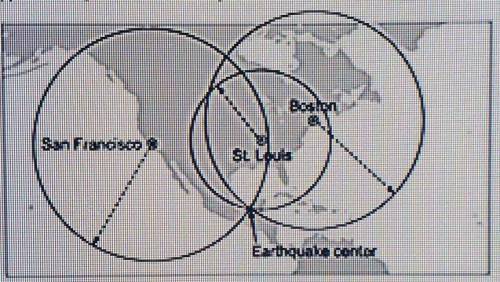
Assignment: Locating the Epicenter Exploration All over the Earth, seismographic stations keep their instruments operating all the time. By Uming the animal of Pwaves and Swaves, scientists at each station can tell how far their station is from the source of any earthquake. That distance is used as the radius of a drde around the gallon on a map of the world. The radius is the dislance from the center of the circle to any point on the clrcle. By comparing the distance from several stallons, selsmologists can locate the earthquake's epicenter. Look at the map. Notice that the three circles ovedap. The location where they overlap is the approximate epicenter of the earthquake.
Finding the Epicenter Find the length of the radius of each circle. To calculate the radius, divide the distance from the eplcenter by 640 am Seismograph records were obtained from an earthquake in Central America. Using the Informabon in the table, locate the epicenter on the map. You will need a compass and ruler. On this map. 1 cm is equal to 640 km
Buenos Aires 1 min, 50 sec 1,600 km
Lima 3 min, 45 sec 2,400 km
Brasilia 4 min, 5 sec 2,880 km


Answers: 3
Another question on Physics

Physics, 21.06.2019 17:10
Aspecial electronic sensor is embedded in the seat of a car that takes riders around a circular loop-the-loop ride at an amusement park. the sensor measures the magnitude of the normal force that the seat exerts on a rider. the loop-the-loop ride is in the vertical plane and its radius is 23 m. sitting on the seat before the ride starts, a rider is level and stationary, and the electronic sensor reads 740 n. at the top of the loop, the rider is upside down and moving, and the sensor reads 370 n. what is the speed of the rider at the top of the loop?
Answers: 1

Physics, 22.06.2019 08:30
If an astronaut takes an object to the moon the following is true (choose only one). a the mass will change but the weight will be the same. b both the mass and the weight of the object will be the same. c the weight will change but the mass will be the same. d both the mass and the weight of the object will change.
Answers: 1

Physics, 22.06.2019 09:00
A2000 kg car is rounding a curve of radius 200 m on a level road. the maximum frictional force the road can exert on the tires of the car is 4000 n. what is the highest speed at which the car can round the curve?
Answers: 1

Physics, 22.06.2019 19:30
Amass m = 74 kg slides on a frictionless track that has a drop, followed by a loop-the-loop with radius r = 18.4 m and finally a flat straight section at the same height as the center of the loop (18.4 m off the ground). since the mass would not make it around the loop if released from the height of the top of the loop (do you know why? ) it must be released above the top of the loop-the-loop height. (assume the mass never leaves the smooth track at any point on its path.) 1. what is the minimum speed the block must have at the top of the loop to make it around the loop-the-loop without leaving the track? 2. what height above the ground must the mass begin to make it around the loop-the-loop? 3. if the mass has just enough speed to make it around the loop without leaving the track, what will its speed be at the bottom of the loop? 4. if the mass has just enough speed to make it around the loop without leaving the track, what is its speed at the final flat level (18.4 m off the ground)? 5. now a spring with spring constant k = 15600 n/m is used on the final flat surface to stop the mass. how far does the spring compress?
Answers: 3
You know the right answer?
Assignment: Locating the Epicenter Exploration All over the Earth, seismographic stations keep their...
Questions







Mathematics, 19.03.2020 05:15

Mathematics, 19.03.2020 05:15

Mathematics, 19.03.2020 05:15

Mathematics, 19.03.2020 05:15


Health, 19.03.2020 05:16


History, 19.03.2020 05:16





Mathematics, 19.03.2020 05:16





